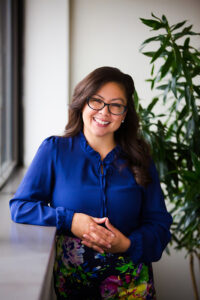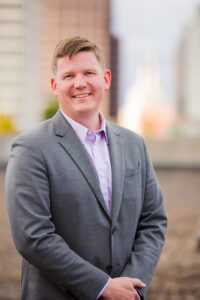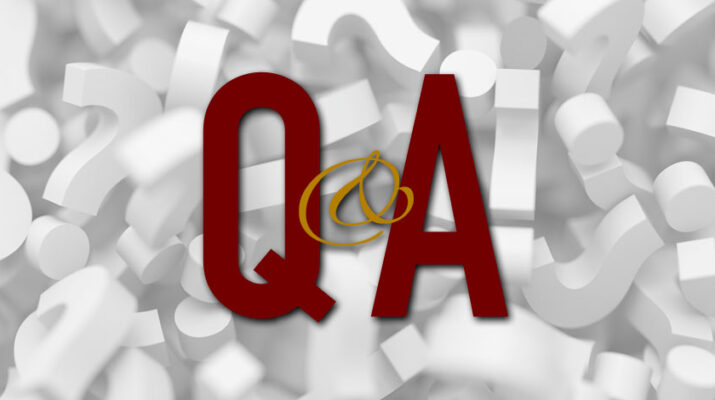In Good Health recently interviewed two leaders of Greater Rochester Health Foundation: president and CEO Matthew Kuhlenbeck and communications officer Tiana Flynn-Stephens. They talked about the organization, its mission, funding and racial health equity.
By Todd Etshman
Q: Please describe the Greater Rochester Health Foundation and how it operates.
Flynn-Stephens: Centered in equity, the Greater Rochester Health Foundation is on a mission to pursue and invest in solutions that build a healthier region where all people can thrive. Our mission reflects our view of health — recognizing that health outcomes are shaped by the conditions in which people live, work, learn, play and receive care — and that inequities in these determinants give rise to health disparities. In addition to our grant-making, we seek to effect change both upstream and downstream and to contribute to policy and systems changes that create more equitable access to resources, opportunities, and power.

Q: Describe where GRHF funding comes from and how it’s distributed to partners.
Flynn-Stephens: The Health Foundation was created in 2006 when the nonprofit MVP Health Plan acquired the nonprofit HMO Preferred Care. The value of Preferred Care was returned to the community through MVP’s purchase price of $232 million to create a foundation dedicated to improving the health of the Greater Rochester community, inclusive of Genesee, Livingston, Monroe, Ontario, Orleans, Seneca, Wayne, Wyoming, and Yates counties. Since its inception, the Health Foundation has acted as an independent foundation governed by a community-based board of directors and managed by a 13-member professional staff. In 2020, the Health Foundation awarded 78 new grants with a total new investment of $5.4 million and total program expenditures of $9 million. We welcomed 33 first-time grantees.
Q: Describe how GRHF works with partners and who the partners are.
Flynn-Stephens: Partnerships are a core organizational value of the Health Foundation. To live this value, we are committed to listening to and collaborating with stakeholders across communities, sectors, and differences. Some of our key partners are: ROC the Future, an alliance of 60+ leading Rochester-area institutions and community partners that promote alignment of community resources to improve the academic achievement of Rochester’s children; the Rochester/Monroe Anti-Poverty Initiative — a multi-sector community collaborative with a goal to improve quality of life by reducing poverty and increasing self-sufficiency; and the Parent Engagement Collaborative Action Network, formed in an effort to improve engagement of parents and families with all aspects of their children’s development and education.
Q: Besides the COVID-19 challenges, what are the other complex community health challenges in the nine-county service area?
Flynn-Stephens: In addition to the complex community health challenges created or amplified by COVID-19, we seek to catalyze change in: access to healthcare services, resources and supports; whole child health; poverty; lower life expectancy rates and the public health crisis of racism. Last summer, we launched a new formal effort focused on racial health equity. This work was developed from gathering ideas and insights through conversations with leaders of color who helped co-create the approach and identify areas of investment. We’ve sought to ground our Racial Health Equity work in trust, investing in grassroots and other organizations with deep community knowledge and credibility.
Q: How has COVID-19 impacted the work you were already doing?
Flynn-Stephens: When COVID-19 hit, we immediately allocated funds to and began participating in the Community Crisis Fund, created as a centralized funding pool to rapidly deploy resources to nonprofits serving communities most impacted by the pandemic. We also directed funds to support public health communications, emergency assistance, direct services, and resources for nonprofits who they, themselves, were trying to keep the lights on while serving the community amidst the crisis. New Health Foundation COVID Response grant funds helped to support food aid and other basic needs assistance as well as youth engagement, child abuse advocacy, domestic violence and mental health supports, and other services.
Q: Can you describe some of the grants you’ve given that are in the annual report?
Flynn-Stephens: We award grants through our three general program areas: responsive, targeted, and partnerships. We look to balance openness to new ideas, community priorities, and emerging health issues with sustained investment in specific areas of focus as well as our contribution to collective impact and other collaborative community efforts.
Q: What is the most satisfying aspect of the foundation’s work from your perspective in the time that you’ve been here?

Matthew Kuhlenbeck: So far, the most satisfying aspect of the Health Foundation’s work has been better connecting with those who are, or will be, recipients of the programs and services we support. Over the past few years, we have been actively working to ensure that community voice is included in the efforts we support to ensure those efforts are meeting their needs. Stronger engagement among our nonprofit partners and those they are serving has resulted in stronger, more effective programming.
Q: What challenges or obstacles concern you moving forward?
Kuhlenbeck: The American Rescue Plan and other pieces of federal legislation are making available a level of resources to communities not seen since the New Deal. With these opportunities come unprecedented challenges in identifying projects ready for these supports, coordinating how to respond to resource opportunities, and finding ways to do this in a manner that addresses systemic challenges for our region and creates an equitable recovery process that seeks to address the inequities that have been identified over the past two years. If the pandemic taught us anything, it is that we have so many challenges in our region that to go back to normal would be less than desirable. Moving from “back to normal” to taking our learnings and improving and addressing the challenges COVID-19 exposed is a crucial step — but is also incredibly challenging. This approach forces us to look at where we are falling short as a region, to seek new solutions and change the structures that were in place pre-pandemic to ensure they are not the “normal” moving forward.
Q: Are this area’s needs any different from the rest of the country?
Kuhlenbeck: I’ve said this many times to my team, “if you’ve seen one community, you’ve seen one community.” Each community and region are unique in many ways and the Rochester region is no different.
Q: Can you describe the future of GRHF and the service area?
Kuhlenbeck: Closing out 2021 — and going forward — we are positioned to continue to be a resource to help our grantees and partners navigate what’s ahead. We pledge to lean into what we have learned to be even more effective and supportive — and will continue to grow and evolve as an organization and a community partner seeking to realize a just and equitable region where all people can thrive.

